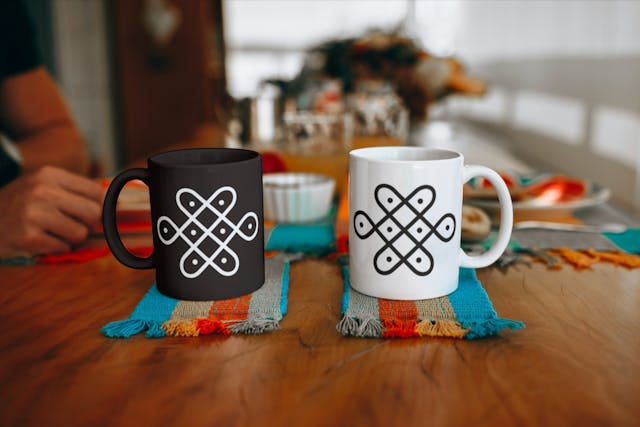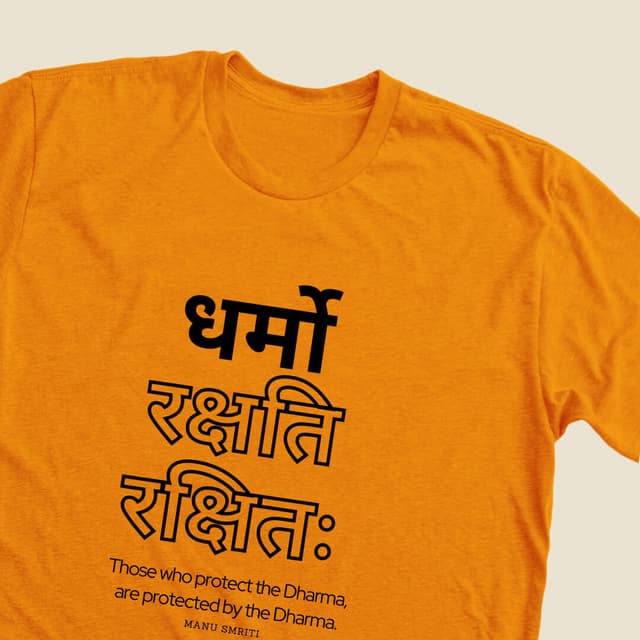
Durga
Durga is portrayed as a warrior woman riding a lion or a tiger, with multiple hands holding weapons and performing mudras or symbolic hand gestures. This Goddess manifestation represents feminine and creative energy (Shakti).
Durga- A divine Prakriti
According to the Markandeya Purana’s Devi Mahatmya, the form of Durga was created as a warrior goddess to fight the demon Mahishasura. Rambha, the demon king, once fell in love with a water buffalo, and Mahishasur was born from this union. As a result, he can switch between human and buffalo forms at will (mahisha means “buffalo”). Mahishasura obtained the boon of not being defeated by any man or god through intense prayers to Brahma. He invaded the gods, who sought assistance from the supreme trinity (Brahma, Vishnu, and Rudra), but Mahishashura defeated all of the gods, including the trinity itself. He wreaked havoc on the earth, heaven, and the netherworlds.
Because only a woman could kill him, the trinity bestowed a brilliant beam of energy on Uma/Parvati, Shiva’s wife, transforming her into the goddess Durga. Her form was stunning, with three lotus-like, blood-bordered eyes, ten powerful hands, black pearl-like hair, and a golden glow from her skin. Shiva sculpted her face, Indra sculpted her torso, Chandra (the moon) sculpted her breasts, Brahma sculpted her teeth, the Earth sculpted her bottom, Varuna (the wind) sculpted her thighs and knees, and Agni sculpted her three eyes (fire).
Each god also bestowed upon her their most powerful weapons, such as Rudra’s trident, Vishnu’s discus, Indra’s thunderbolt, Brahma’s kamandal, Kuber’s gada, and so on. The Himalayas bestowed upon her a white fierce lion. Chanda and Munda arrived to fight the goddess on the end of the eighth and beginning of the ninth day of the waxing moon. Goddess Chamunda leaped out of her third eye as she turned blue with rage. Her form was the most powerful, with three red eyes, a blood-filled tongue, and dark skin, and she was the one who finally killed the twin demons with her sword.
This form of the divine goddess is worshipped as sandhi/chandi puja during the sandhikshan of the Durga Puja festival. Finally, on the tenth day of the waxing moon, goddess Durga used her trident to kill Mahishasura.
The word Shakti, which means strength, reflects the goddess’s warrior aspect, embodying a traditional male role. But she is also stunningly beautiful, and Mahishasura attempts to marry her at first. Annapurna and Karunamayi (karuna = kindness) are two other incarnations.
Iconography
The four-day Durga Puja festival is the most important annual festival in Bengal and other parts of Eastern India. However, it is observed in various ways throughout the Hindu universe.
The day of Durga’s victory is known as Vijaya Dashami in East and South India, Dashain in Nepal, and Dussehra in North India – these words literally mean “the tenth” (day), and vijayA means “of-victory.” In Kashmir, she is known as Shaarika (the main temple is in Hari Parbat in Srinagar)
However, the actual period of worship may be on the preceding nine days, followed by the final day known as Vijayadashami in North India or five days in Bengal (from the sixth to tenth day of the waxing-moon fortnight). During the nine-day festival, devout Shakti worshippers meditate on nine aspects of Durga known as Navadurga, one by one.
This tenth day, which commemorates Rama’s victory over the demon Ravana, is celebrated as Dussehra in North India, with massive straw effigies of Ravana being burned in designated open spaces (e.g., Delhi’s Ram Lila grounds), watched by thousands of families and small children.
In Gujarat, it is celebrated as the final day of Navaratri, during which the Garba dance is performed to commemorate Mahishasura-mardini Durga’s victorious victory. Many temples in Karnataka’s Dakshina Kannada district honor Goddess Durga.
Durga Puja
Durga Puja is the most important festival for Bengali Hindus. Akalbodhan is also known as Vijaya Dashami, Dashain, and Dussehra. However, the actual period of worship may be over the preceding nine days of Navaratri or five days (“Sasthi”, “Saptami”, “Asthami”, “Nabami” & “Vijaya Dashami”).
Durga Puja in Bengal
Durga as a modern symbolic representation. The autumn (Shôrot) worship of Durga (Durgapuja) is the year’s largest Hindu festival in West Bengal, Orissa, Tripura, Assam, and other parts of East India, as well as Bangladesh. Durga Puja is also observed in Nepal and Bhutan, with local customs and variations. Durga’s Puja is celebrated from the sixth to tenth day of the waxing moon in the Bengali calendar month of Ashshin, which is the sixth month. Due to shifts in the lunar cycle relative to the solar months, it may also be held in the following month, Kartik, on occasion. These dates correspond to September/October in the Gregorian calendar.
Rama invokes the goddess Durga in his battle against Ravana in the Krittibas Ramayana. Although she was traditionally worshipped in the spring, Rama had to invoke her in the autumn due to battle contingencies (akaal bodhan). Today, the Rama Puja has taken precedence, though the spring Puja, known as Basanti Puja, is also included in the Hindu calendar. The puja is also known as Sharodia because it takes place during the Shôrot (autumn) season.
The pujas are held over a five-day period to commemorate the return of the married daughter, Durga, to her father, Himalaya’s, home. It is Bengal’s most important festival, and Bengalis celebrate by wearing new clothes and other gifts in the evenings when the family goes out to see the pandals (temporary structures set up to venerate the goddess). Although it is a Hindu festival, religion takes a back seat during these five days: Durga Puja in Bengal is a carnival in which people from all walks of life, regardless of religious beliefs, participate and have a good time.
Kolkata
More than two thousand pandals have been established in Kolkata alone, all vying for the admiration and praise of the populace. The city is decked out in lights. At this time of year, people from all over the country flock to the city, and every night is a wild carnival with thousands of people going ‘pandal-hopping’ with their friends and family. After a certain point, traffic becomes a nightmare, and most people abandon their vehicles to travel by foot.
Bangladesh
Bangladesh celebrates the puja in many temples, with an estimated 18,000 puja mandaps set up across the country, including more than 140 pujas in the capital Dhaka alone. The Bangladesh Puja Udjapan Parishad is one of the largest organizations in charge of organizing the country’s annual celebrations. Unlike in India, where politicians usually keep a low profile at pujas, Durga Puja in Bangladesh is a major opportunity for leading politicians from major political parties to reach out to their Hindu constituents..
The President, Prime Minister, and Leader of the Opposition make official statements, and political party leaders can be seen at the largest Durga Puja mandaps, such as those at Dhakeshwari Mandir and Rama Krishna Mission. Bijaya Dasami, the last day of Durga Puja, is a national holiday in Bangladesh, and all government offices and most private businesses are closed.
In the diaspora
Durga Puja serves as a community gathering and a connection to roots for the world’s Bengali diaspora. There are nearly ten Pujas in Tokyo, and hundreds more in North America. For over seventy years, the United Kingdom has hosted some of the oldest Durga Puja celebrations outside of Bengal. Bengali communities in Australia, France, and Germany have also begun annual Durga Puja celebrations in recent years.
Many Bengali communities in the Middle East have been unable to celebrate due to local government restrictions on minority religious practises. Since 1982, Muscat, Oman has hosted the most consistent Durga Puja in the Gulf region. Since 1994, the annual celebration has been held at the Hindu temple in Sohar, in old Muscat.
History
Durgotsavnirnaya (11th century), Durgabhaktitarangini by Vidyapati (14th century), and other works exist in Bengali and its early forms surrounding Durga. Durga Puja was popular in mediaeval Bengal, with records of it being held in the courts of Rajshahi (16th century) and Nadia (18th century). However, it was not until the 18th century that Durga worship became popular among Bengal’s landed elite, known as zamindars. The landed zamindars and jagirdars, enriched by British rule, conducted prominent Pujas, including Raja Nabakrishna Deb of Shobhabajar, who initiated an elaborate Puja at his residence. Many of these old pujas still exist today. Today, the culture of Durga Puja has shifted from princely houses to Sarbojanin (literally, “involving all”) forms.
The Mahishasuramardini’ radio programme, which has been popular with the community since the 1950s, kicks off the Durga puja mood. Previously, it was conducted live, but later, a recorded version began to be broadcast. Bengalis traditionally wake up at 4 a.m. on Mahalaya day to listen to the enchanting voices of the late Birendra Kishore Bhadra and the late Pankaj Kumar Mullick reciting hymns from the scriptures ‘Devi Mahatmyam’ on All India Radio.
During the week of Durga Puja, the entire state of West Bengal, as well as large enclaves of Bengalis all over the world, come to a halt. Extensive structures known as pandals are set up in playgrounds, traffic circles, and ponds – wherever space is available – with many taking nearly a year to plan. The term pandal refers to a temporary structure made of bamboo and cloth that is used as a temporary temple for puja. While some pandals are simple structures, others are often elaborate works of art with themes based on history, current events, and sometimes pure imagination.’
Somewhere within these intricate structures is a stage where Durga reigns, astride her lion mount and wielding ten weapons in her ten hands. On the mornings of the sixth to ninth days of the waxing moon fortnight known as evi Pakshya (lit. Devi = goddess; Pakshya = period; Devi Pakshya meaning the period of the goddess), crowds gather to offer flower worship or pushpanjali. Ritual drummers, known as dhaakis, demonstrate their abilities during aarati ritual dance worship by carrying large leather-strung dhaakis.
Durga the mother returns to her husband, Shiva, on the tenth day, ritualized by her immersion in the waters — Bishorjon, also known as Bhaashan and Niranjan.
Today’s Puja, on the other hand, goes far beyond religion. In fact, after visiting the pandals in recent years, one can only conclude that Durgapuja is the world’s largest outdoor art festival. In the 1990s, architectural models predominated on pandal exteriors, but today the art motif extends to elaborate interiors, executed by trained artists, with consistent stylistic elements, meticulously executed, and bearing the artist’s name.
The idol’s sculpture has evolved over time. Durga is always depicted with her four children, as well as two attendant deities and some banana-tree figures. Traditionally, all five idols would be depicted in a single frame, known as pata. However, since the 1980s, the trend has been to depict each idol separately.
At the end of six days, the idol is carried in a procession to a river or other body of water amid loud chants of ‘Durga mai-ki jai’ (‘glory be to Mother Durga’) and ‘aashchhe bochhor abar hobe’ (‘it will happen again next year’) and drumbeats, and it is cast in the waters symbolic of the deity’s departure to her home with her husband in the Himalayas Following this, families visit each other in a tradition known as Vijaya Dashami, and sweetmeats are offered to visitors (Dashami is literally “tenth day” and Vijay is “victory”).
New Delhi’s Durga pandal. Durga Puja is also a celebration of Good (Ma Durga) triumphing over Evil (Maheshasoora the demon). It is a worship of the power of the Good, which always triumphs over the Evil.
Durga Puja is celebrated in other parts of India.
Maharashtra
Durga Puja is a joyous occasion in Maharashtra. Every day, devotees perform puja and do not remove the flower garland that is placed on the deity’s idol or image. After nine days, all nine are removed at the same time. Young girls who have not reached the age of maturity are invited to eat, play games, dance, and sing. Rangoli is used to draw an elephant, and the girls play guessing games. They are then served a meal of their choice.
Punjab
Punjabis observe Navratri religiously. Before breaking the fast on Ashtami or Navami, some Punjabis only consume milk for seven days. They worship Durga Ma at home and perform the aarti. Some of them eat fruit or a full meal once a day, and they avoid intoxicating drinks, meat, and other forms of entertainment. At the end of the fast, devotees feed beggars or worship little girls who spell the Mother Goddess’ Shakti.
Gujarat
Navratri is a festival dedicated to Amba Mataji. According to accepted practise, images of Mataji are worshipped in some homes. This is also true for temples, which typically have a steady stream of visitors from morning to night. The most common form of public celebration is the late-night performance of garba and dandia-ras/ras-garba (a form of garba with sticks), Gujarat’s popular folk-dance, in public squares, open grounds, and streets during these nine days.
Kerala
Durga Puja marks the start of formal education for all children aged 3-5 years in Kerala. While puja takes place in the temple for the entire ten days, the final three days are crucial. Ashtami is Ayudya Puja day, when all household tools are worshipped. It is customary not to use any tools on this day. On Navami, Goddess Saraswati is honored at home by worshipping the books and records. Thousands flock to the Saraswati temple in Kottayam during this time to bathe in the mysterious holy pond, the source of which is unknown. Large crowds can also be seen at Thekkegram (Palghat) temples, which have no idols but instead large mirrors.
A devotee may find himself bowing in front of his own reflection, indicating that God is within us.
Kashmir
In Jammu and Kashmir, Hindus are a minority, but they celebrate their festivals with pomp and show. However, celebrations are more subdued these days. Kashmir’s favorite deities are Lord Shiva and Serawali Ma Durga, the tiger-riding goddess. Both Hindus and Muslims agree that Navratri is significant. There are no large pandals here; each Hindu household performs pooja at home. The entire adult population of the household fasts on water. Fruit may be consumed in the evenings. Kashmiris grow barley in earthen pots, as they do elsewhere. They believe that if the growth in this pot is good, the year will be prosperous.
For Kashmiri Pandits, the most important ritual is to visit the temple of the guardian goddess Kheer Bhawani on all nine days. On the final day of Navratri, an aarti is performed at the temple, following which people break their fast. Ravana’s effigy is burned on Dussehra.



